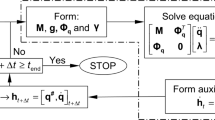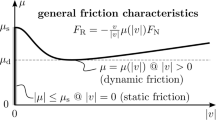Abstract
An improved friction model was proposed with consideration of the effect of the sliding speed, the contact pressure and the temperature, and it was implemented into a user subroutine of a commercial FEM code, ABAQUS/Explicit. Then, a smooth tire was simulated for free rolling, driving, braking and cornering situations using the improved friction model and the Coulomb friction model, and the effect of the friction models on the slip, the frictional energy distribution and the cornering force and moment was analyzed. For the free rolling, the driving and the braking situations, the improved friction model and the Coulomb friction model resulted in similar profiles of the slip and the frictional energy distributions although the magnitudes were different. The slips obtained from the simulations were in a good correlation with experimental data. For the cornering situation, the Coulomb friction model with the coefficient of friction of 1 or 2 resulted in lower or higher cornering forces and moments than experimental data. In addition, in contrast to experimental data it did not result in a maximum cornering force and a decrease of the cornering moment for the increase of the speed. However, the improved friction model resulted in similar cornering forces and moments to experimental data, and it resulted in a maximum cornering force and a decrease of the cornering moment for the increase of the speed, showing a good correlation with experimental data.
Similar content being viewed by others
References
ABAQUS, 2000,User’s Manual, Hibbit, Karlsson & Sorenson, Inc., Version 5.8.
Berthelot, J.-M., 1997,Composite Materials Mechanical Behavior and Structural Analysis, Springer.
Clark, S. K., 1981,Mechanics of Pneumatic Tires, U. S. Department of Transportation, NHTSA, Washington D. C., DOT HS805-952.
Dorsch, V., Becker, A. and Vossen, L., 2002, “Enhanced Rubber Friction Model for Finite Element Simulations of Rolling Tires,”Plastics, Rubber and Composites, Vol. 31, pp. 458–464.
Gall, R., Tabaddor, F., Robbins, D., Majors, P., Sheperd, W. and Johnson, S., 1995, “Some Notes on the Finite Element Analysis of Tires,”Tire Science and Technology, TSTCA, Vol. 23, No. 3, July–September, pp. 175–188.
Goldstein, A. A., 1996, “Finite Element Analysis of a Quasi-Static Rolling Tire Model for Determination of Truck Tire Forces and Moments,”Tire Science and Technology, TSTCA, Vol. 24, No. 4, October–December, pp. 278–293.
Kabe, K. and Koishi, M., 2000, “Tire Cornering Simulation Using Finite Element Analysis,”Journal of Applied Polymer Science, Vol. 78, pp. 1566–1572.
Kao, B. G. and Muthukrishnan, M., 1997, “The Transient Analysis with an Explicit Finite Element Program,”Tire Science and Technology, TSTCA, Vol. 25, No. 4, October–December, pp. 230–244.
Lee, D.-J., Nahm, S.-W., Jeong, H.-Y. and Kim, Y.-H., 2001, “A New Friction Model and Its Implications for the Frictional Energy and the Contact Forces,” 20th Annual Meeting and Conference on Tire Science and Technology.
Persson, B. N. J., 2001, “Theory of Rubber Friction and Contact Mechanics,”Journal of Chemical Physics, Vol. 115, pp. 3840–3861.
Wang, T.-M, Daniel, I. M. and Huang, K., 1996, “Stress Analysis of Tire Sections,”Tire Science and Technology, TSTCA, Vol. 24, No. 4, October–December, pp. 349–366.
Williams, M. L., Landel, R. F. and Ferry, J. D., 1955,Journal of American Chemistry Society, Vol. 77, p. 3701.
Wu, S. R., Gu, L. and Chen, H., 1997, “Airbag Tire Modeling by the Explicit Finite Element Method,”Tire Science and Technology, TSTCA, Vol. 25, No. 4, October–December, pp. 288–300.
Author information
Authors and Affiliations
Corresponding author
Rights and permissions
About this article
Cite this article
Park, K.S., Oh, C.W., Kim, T.W. et al. An improved friction model and its implications for the slip, the frictional energy, and the cornering force and moment of tires. J Mech Sci Technol 20, 1399–1409 (2006). https://doi.org/10.1007/BF02915963
Received:
Revised:
Issue Date:
DOI: https://doi.org/10.1007/BF02915963




